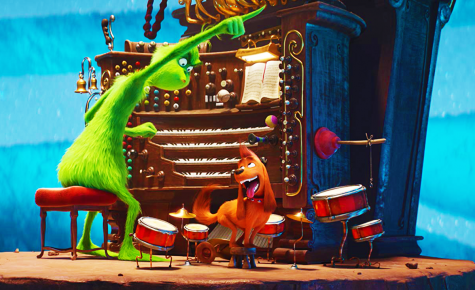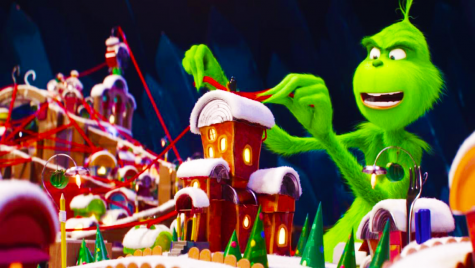“The Grinch” shouldn’t be touched with a thirty-nine-and-a-half foot pole
December 15, 2018
Prolific animation studio Illumination, creator of the “Despicable Me” series and the inescapable Minions, released their own interpretation of one of Dr. Seuss’ classic Christmas tales, simply called “The Grinch.” The original film, “How the Grinch Stole Christmas,” is a holiday classic viewed by thousands of families across the globe every year. So does Illumination’s smooth, 3D remake hold a candle to its inspiration? No. Not at all. In fact, much like the title character, “The Grinch” is an utterly joyless experience.

This film’s greatest problem lies in its length. The original film ran at a quick, concise 26 minutes, more than enough time to convey the entire story. “The Grinch,” however, adds an additional hour on top of that. Of course, the story of the Grinch doesn’t have enough substance to be stretched out to an hour and a half, so the film relies on relentless filler and unnecessary scenes. The vast majority of the runtime is spent preparing for the Grinch’s Christmas heist. Some characters, specifically the moose and reindeer, are introduced in these scenes only to be abruptly cut before the actual heist, making their inclusion all the more confusing. These scenes do nothing to progress the plot and yet are included seemingly with the arbitrary goal of making the film “movie length.” Technically, “The Grinch” is shorter than most films, and yet every moment feels like an eternity.
The only substance the elongated story has to show for itself is the “comedy,” which, typical to an Illumination film, is bottom of the barrel and obnoxious. Unlike other well known animated studios, Illumination makes films for young children who can’t judge its quality. The studio passes off their unoriginal and unfunny jokes as “made for kids,” even though “for kids” and “quality” aren’t mutually exclusive.
Anyone who hasn’t been living under a rock has likely been subjected to the flood of “Grinch” advertisements which pollute Instagram feeds and loom over traffic on billboards. These advertisements truly solidify the manipulative, pandering attitude Illumination took to make this film “relevant” for kids and teens. Why else would they enlist popular rapper Tyler, the Creator to make not one, but two awful songs to be used in the soundtrack? One such song is a remake of the classic “You’re a Mean One, Mr. Grinch,” whose original purpose is destroyed by Tyler’s underwhelming vocals and eye-rolling lyrics. Another soundtrack choice that stands out is the very explicit “BOOGIE” by Brockhampton from their album SATURATION III, which is so out of place in a children’s movie that it was barely played. Again, this is just another desperate appeal to seem “cool” when all of it is forced.

As for the technical aspects, there isn’t much to note. If there’s anything to be said about Illumination films, it’s that they generally have excellent animation. The city of Whoville is bright and vibrant and the gadgets that the Grinch uses are fun and creative. Despite this, there are still some visual aspects which stand out negatively. The Grinch’s cutesy design ruins the original intention of the character being evil and manipulative, turning him into an easily sellable plush toy. In the same vein, Benedict Cumberbatch’s performance as the Grinch (yes, really) takes the character in a nasally, boring direction. The rest of the cast conveys their characters adequately, and even the surprise appearance from Pharrell Williams as the narrator didn’t distract too much (even if it reads as desperate).
However, no matter what aspects you look at individually, there’s no denying that “The Grinch” is a fundamentally flawed project. The original film already exists, and there’s no reason to try to capture the magic again when it’s always there to watch. And compared to the original, as well as standing on its own, “The Grinch” is bloated, unfunny, unoriginal and trying way too hard to seem hip. Don’t touch this one with a thirty-nine-and-a-half foot pole.







